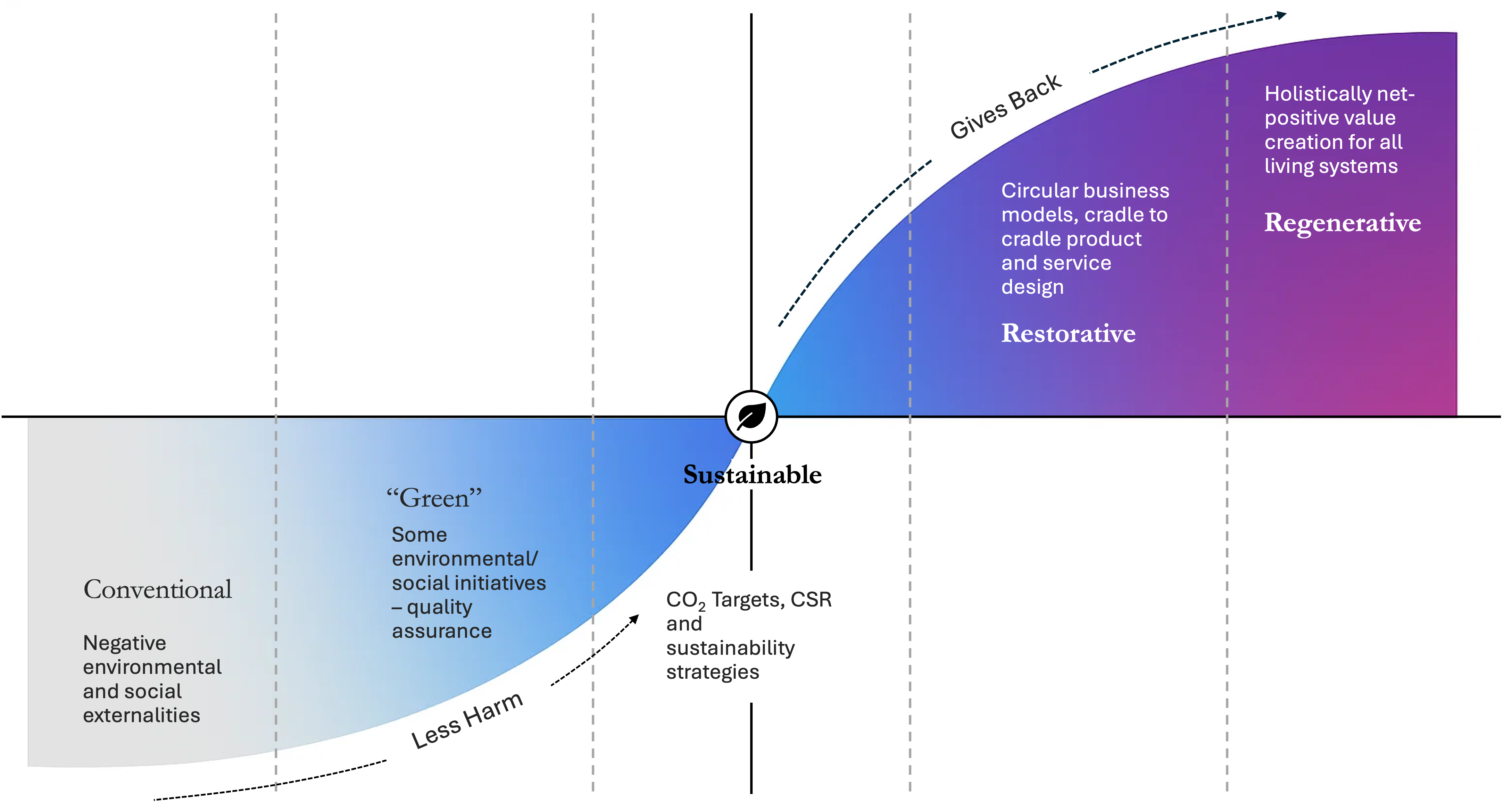Regenerative innovation: Business models that promote life
Companies and organizations often try to fix systemic problems with familiar and well-practiced measures, using temporary solutions that are comparable to sticking plasters, tape, and glue on structural defects. These approaches cannot solve fundamental problems, because they only address issues superficially. The recognition is growing that old, growth-focused business models have no future. Companies need to understand that the disruptions ahead demand deeper, systemic regeneration rather than mere repairs.
Adopting a future-focused mindset reframes crisis as a portal to unearth regenerative opportunities through shared narratives, co-creation, speculative thinking, and scenario building. Regeneration in business becomes an opportunity to address root causes of ecological degradation and social displacement. The aim is not just to sustain current conditions, but to actively improve the health of all living systems. By combining perspectives from various cultures and philosophies, businesses can better navigate the challenges ahead.
Before exploring how regeneration can guide organizations toward meaningful transformation, it is essential to define “Regeneration” itself.
What is Regeneration?
Why is it necessary? How does it differ from sustainability?
Regeneration signals a profound evolution beyond sustainability. Sustainability maintains business as usual as it strives to reduce harm, not do further damage. In contrast, regeneration demands active restoration, revitalizing ecosystems, strengthening communities, and nurturing living systems. It calls for businesses to move from passive conservation toward dynamic renewal, recognizing the interconnectedness of human and natural systems as co-dependent and co-evolving.

Image: Adopted from: Ethica; Regenerative Capital Group
The concept of regeneration is not a novelty and has been associated with various fields – agriculture, architecture, design and tourism. In the mainstream discourse, the regenerative model, in particular regenerative agriculture has been around since the 1970s with the aim of restoring and replenishing land and its people. However, practices rooted in regeneration have been observed for centuries across different cultures around the world – intercropping, polycultures, agroforestry, permaculture, terracing, silviculture, etc. While there are many interpretations and philosophies of regeneration and regenerative agriculture, the defining shift is toward practices that focus on ecosystem processes and relationships rather than simply outputs.
In regenerative thinking, the relationship among people, nature, and business becomes central. Companies no longer view nature only as a resource to be exploited but recognize it as a partner. It is not enough to minimize damage, since regeneration requires enhancing planetary wellbeing. This generates resilience and legitimacy and offers a necessary alternative as business-as-usual loses credibility. Many current models of regenerative business are closely tied to nature-based industries. Sectors such as agriculture, forestry, fishing, mining, energy, and construction remain highly dependent on ecological systems. It is estimated that 55% of global GDP is directly linked to nature’s services.
The pathway to regeneration often begins with advancing beyond sustainability and circularity toward restoration. In architecture and design, biomimicry offers a powerful example of this transition. By emulating nature’s time-tested patterns and strategies, architects create passive climate-resilient buildings that work with ecosystems rather than against them. Projects inspired by indigenous knowledge, such as the climate-adaptive earth architecture in hot arid regions of North Africa or Indigenous owned and operated savannah fire projects in Australia, show how restoration and renewal can be embedded in design and with local community. These approaches reduce energy use, enhance biodiversity, and foster harmony between built and natural environments. Such initiatives demonstrate that businesses and industries worldwide can begin regeneration by adopting ethical, place-based strategies rooted in both traditional wisdom and cutting-edge innovation.
Status of Regeneration Today
The case for regeneration is strong. Consumer and market trends highlight the importance of going beyond just “sustainability” by embodying renewal and growth. A 2019 survey by ReGenFriends found that, when offered a transparent definition of regenerative value creation, nearly 80% of U.S. consumers would prefer regenerative brands to sustainable ones. The upheavals and changes since 2019 do suggest that society has become focused on issues other than sustainability in current times. However, awareness of regenerative business models continues to grow, particularly among value-based groups and Gen Z and Millennials. As is the willingness to pay a premium for them. A 2024 survey by Regenified found that 56% of Value-Based Shoppers in the U.S are willing to a premium for regenerative products.
Global conglomerates such as Danone, Nestlé, Cargill and Walmart are integrating regenerative agriculture into their supply chains. Danone attributes its transition primarily to consumer preferences for brands that promote health and wellbeing. By contrast, Nestlé's significant investments in regenerative farming are driven by concerns about supply chain resilience, recognizing that regenerative practices mitigate risks and bolster operations amidst climate disruption. However, it remains to be seen to what extent these companies will truly incorporate regenerative practices across their entire value chain, including beyond agriculture, given historical allegations of corporate greenwashing and inequitable practices.
Financial outcomes support the case for regeneration. For crop farmers, regenerative agriculture can outperform conventional methods by approximately €250 per hectare after 6 to 10 years due to avoided yield losses, reduced fertilizer and crop-protection costs, and additional income from carbon credits. Studies show that each hectare of land restored soil can also sequester roughly 3 tons of atmospheric CO₂, a figure that points to enormous climate mitigation potential when applied across the roughly 5 billion hectares of cultivated land worldwide.
Taken together, these shifts highlight why regeneration is becoming central to business success. It offers ecological renewal, financial resilience, and social legitimacy while aligning with consumer values. What emerges is not a static model but a living process that adapts, evolves, and embeds co-creative relationships across ecosystems and communities.
Navigating Coloniality: Reconciliation and Transcultural Integration
As regeneration becomes prevalent, it is very important acknowledge and navigate the colonial legacies that shape current knowledge and practices. Coloniality of knowledge refers to the dominance of Western ways of understanding and interacting with the world. This dominance often excludes or marginalizes indigenous and non-Western knowledge, methods and perspectives. Recognizing this bias is essential for authentic regenerative transformation because it ensures plural worldviews are respected and integrated.
It has become apparent in present times that sustainability frameworks have been co-opted often with the exclusion of marginalized voices and increasingly with a focus to preserve the status-quo. This cannot be repeated with regeneration. The inherent definition of regeneration places emphasis on all living systems and diverse, pluralistic perspectives, world views and frameworks.
As such, businesses should actively avoid green imperialism and eco-colonial traps. Green imperialism occurs when sustainability initiatives imposed by dominant groups inadvertently reproduce colonial patterns. These initiatives risk undermining local autonomy and imposing external agendas. To prevent such issues, regenerative business practices should embrace transcultural approaches to create balanced, inclusive solutions. This takes a shift from conventional models by truly co-creating with local stakeholders and bio-cultural systems.
Furthermore, indigenous resurgence offers alternative frameworks for transformation that centre on reciprocity, relationality, and holistic wellbeing. Embracing these frameworks allows businesses to genuinely reconcile different worldviews and collaborate meaningfully with indigenous communities. Through transcultural integration and reconciliation, regenerative businesses can achieve deeper, more equitable, and sustainable outcomes.
What Paradigm and Mindset Shifts Define Regeneration?
Regenerative business models are a fascinating and complex concept, requiring an intentional shift in their operating paradigms – a systemic realignment towards regeneration. Below, we summarize the key paradigm shifts, then highlight some frameworks and approaches in theory and practice that distinguish the regenerative approach from sustainable practices:

Regenerative Futures: Frameworks and Case studies
Shifting Towards a New Value Creation Logic
Regeneration requires people and companies to change their approach to value creation. The aim is to transition from extractive, energy-intensive models to living, self-organising systems in which value is created alongside soils, watersheds, communities and cultures. It translates into value being measured by the strength of relationships over time and space, by redirecting material and financial flows towards restoration and circularity.
Enterprises are already adjusting ownership, standards and revenue sharing to reflect this logic. In 2022, Yvon Chouinard, founder of the outdoor apparel company Patagonia, and his family transferred ownership of the company so that the Earth became its main shareholder by 'going purpose'. Under the new model, the Earth benefits from all surplus profits through the Holdfast Collective, while the company's mission is safeguarded by the Patagonia Purpose Trust, operated in a stewardship style. Their supply networks are changing too. The Regenerative Organic Certified programme, launched and overseen by the Regenerative Organic Alliance and other members in 2019, is a revolutionary certification for food, textiles and personal care ingredients. Building upon existing organic agricultural standards, it introduces new requirements for soil health, social fairness and animal welfare for both producers and brands.
New revenue-sharing models are also emerging in the cultural and digital economy. After reaching profitability, the streaming platform Dropout adopted profit sharing with its creative workforce, demonstrating how surplus can be distributed more fairly along the value chain. Meanwhile, GoodDollar is experimenting with a basic income protocol that distributes daily value to hundreds of thousands of participants across more than 180 countries, thereby fostering community commerce and inclusion.
The results are visible. Patagonia reported significant investment in environmental initiatives and community-led conservation in its first years of operation under the new structure. Regenerative Organic Certified farms now span millions of acres and include tens of thousands of smallholders and hundreds of licensed brands, with strong year-on-year growth in retail sales of certified products. Dropout has experienced rapid subscriber growth and has paid end-of-year revenue shares to creatives, thereby reinforcing retention and participation in production.
Cultivating Adaptive and Integrated Organizational Logics
Organisations operating in living systems must be pre-adaptive. They must learn alongside their environments, invest in repair and build coalitions that can mobilise finance on a large scale. The Regenerative Territories programme in Brazil demonstrates how blended finance can combine public, philanthropic and private capital to grow nature-based solutions while supporting the development of local enterprises. In the early phases, crowdlending was used to protect jobs, and now the programme is building capacity and providing seed capital across territories, with the goal of regenerating forests and water systems over the next decade. Learning networks build similar capacity.
Heavy industry is moving in this direction, too. RESOLVE's regeneration initiative launched with Rio Tinto, Apple, Environmental Defence Fund, Mejuri and other businesses targets legacy mine sites, safely remining tailings for critical minerals and reinvesting earnings into habitat restoration. This process documents biodiversity and carbon outcomes while creating new sourcing pathways for brands. In Canada, the concept of Etuaptmumk or 'two-eyed seeing' has been used to as an approach of inquiry and solutions in which the best of Indigenous and Western ways of knowing and practicing are paired to protect land, frame policies and conduct research. Etuaptmumk provides a framework for pairing knowledge systems and promoting universally positive outcomes. In land conservation, shared decision-making with Cree partners supports long-term protection goals while sustaining rights-based livelihoods on the land. These shifts reduce risk exposure, increase social legitimacy and create measurable ecological improvements that build up over time.
Innovation Rooted in Regenerative Competencies
In a regenerative economy, innovation starts with the ability to understand systems as a whole and design them for renewal. Across Latin America, companies and civic initiatives are using artificial intelligence, materials science and data platforms to reduce water usage, regenerate soil and verify results. Kilimo's irrigation analytics demonstrate significant water savings across multiple countries and show that farmers can reduce water usage while maintaining yields. Other efforts target low-carbon dairy production and nanotechnology-based agricultural inputs to reduce methane emissions and dependence on agrochemicals, while platforms such as Lemu connect investors to verifiable restoration projects. These solutions are centred on the needs of specific places and people, creating feedback loops that enhance ecological function.
Sector transitions reinforce this pattern. In the coffee sector, regenerative agroforestry and due diligence tools are being introduced to reduce deforestation while also addressing labour exploitation. This aligns farm-level design with policy shifts, such as the EU deforestation regulation. Early outcomes include verified water savings in agriculture, reductions in measured emissions in livestock systems and stronger market access for projects with auditable ecosystem benefits. As capabilities mature, innovation portfolios shift from single-issue fixes to living processes that strengthen ecosystems and livelihoods simultaneously.
Structured Foresight and Futures Thinking for Regeneration
How can communities and organizations effectively and thoughtfully navigate the path toward regenerative futures? How can they ensure their actions today align with the emerging complexities and needs of our shared world? To support this transformative journey, we have developed a structured foresight approach grounded in regeneration, inclusivity, and reflective practice. Transformation here is an ongoing dialogue, blending clarity of process with sensitivity toward ecological and social dynamics.

Scanning and Exploring
The journey begins with mapping stakeholders, trends, narratives, and foundational assumptions. Engaging across organizations, communities, and ecosystems, we co-create local, contextual definitions of regeneration. The goal is to explore multiple worldviews, metaphors, and the complexity of systems, identifying opportunities for change.
Framing and Narratives
Through collaborative scenario building and storytelling, we create new narratives and tangible artifacts that illustrate regenerative value creation areas: health, mobility, built environments, and more. Such expansive thinking anchors innovation in ecological empathy and interconnectedness.
Design and Impacts
Using systemic tools like causal-layered analysis and systems mapping, we then assess the impacts of regenerative strategies on the company’s functions and processes. Holistic evaluation ensures that efforts advance ecological balance, social cohesion, and cultural vitality, as well as highlighting areas needing attention.
Adapting Processes and Measuring
Concrete pathways are defined using backcasting and adaptive planning. Indicators are developed for ecological, social, cultural, and relational health. Monitoring becomes a reflective, iterative practice that guides alignment and ongoing adaptation.
Embedding and Flourishing
Regenerative principles become embedded in organizational culture and community practice. Engagement and storytelling consolidate a vision for regeneration. As transparent partnerships form, a sense of collective commitment emerges, supporting flourishing across systems.
In Closing
Regenerative business is not a fixed destination, but a continuous journey shaped by curiosity, openness, and shared purpose. Facing complex challenges requires holding multiple perspectives and ways of knowing simultaneously, blending innovation with tradition, and foresight with grounded wisdom. Strategic futures thinking and foresight offer practical tools to navigate this evolving terrain, inviting organizations to imagine diverse and pluralistic futures, set inspiring visions, and chart deliberate pathways. By nurturing this reciprocal dialogue between insight and action, we can help your organization take meaningful first steps toward regeneration, transforming risk into resilience and cultivating the capacity to restore, heal, and flourish within the interconnected systems we all depend on.
References and Further Reading
- Bartlett, C., Marshall, M., & Marshall, A. (2012). Two-eyed seeing and other lessons learned within a co-learning journey of bringing together Indigenous and mainstream knowledges. Journal of Environmental Studies and Sciences, 2, 331–340. https://aeic-iaac.gc.ca/050/documents/p80156/132968E.pdf
- Camrass, K. (2023). Regenerative futures: Eight principles for thinking and practice. Journal of Futures Studies, 28(1). https://jfsdigital.org/articles-and-essays/2023-2/vol-28-no-1-september-2023/regenerative-futures-eight-principles-for-thinking-and-practice/
- Capitals Coalition. (2020). The Capitals approach. https://capitalscoalition.org/capitals-approach/
- Chapman, J., & Reid, B. (2025, January 21). Regeneratively farmed is the new buzz label on supermarket shelves—but what does it actually mean? The Conversation. https://theconversation.com/regeneratively-farmed-is-the-new-buzz-label-on-supermarket-shelves-but-what-does-it-actually-mean-247437
- Dhanani, R. (2023, November 17). The history of regenerative sustainability. The Sustainable Agency Blog. https://thesustainableagency.com/blog/the-history-of-regeneration-and-regenerative-sustainability/
- Forum for the Future. (2021). The business transformation compass: Just and regenerative business. https://www.forumforthefuture.org/Handlers/Download.ashx?IDMF=9a4e9add-03cc-4c10-bb03-8a0c2d559039
- Gellert, R. (2023). What Patagonia’s CEO Has Learned a Year Into the Company’s ‘Radical Experiment’. TIME. https://time.com/6315770/patagonia-ownership-climate-change/
- Holliday, M. (2020). Regeneration and reconciliation in a colonized world. Medium. https://michelleholliday.medium.com/regeneration-and-reconciliation-in-a-colonized-world-ae71d172dee7
- Inayatullah, S. (2008). Six pillars: Futures thinking for transforming. Foresight, 10(1), 4–28. https://www.metafuture.org/library1/FuturesStudies/Six-pillars-Foresight-2008.pdf
- Konietzko, J., Das, A., & Bocken, N. (2023). Towards regenerative business models: A necessary shift? Sustainable Production and Consumption, 38, 372 -388. https://doi.org/10.1016/j.spc.2023.04.014
- Nebel, B., & Perumbally, F. (2020, July). Sustainability and regeneration: Friends or foes? thinkstep-anz. https://www.thinkstep-anz.com/resrc/blogs/sustainability-and-regeneration-friends-or-foes/
- Parodi, O., Ayestaran, I., & Banse, G. (Eds.). (2011). Sustainable Development (1–). KIT Scientific Publishing. https://books.openedition.org/ksp/4266
- Rose, J. F. P. (2021, November 1). How businesses can regenerate the global commons. Stanford Social Innovation Review. https://ssir.org/articles/entry/how_businesses_can_regenerate_the_global_commons
- Ryan, N., Beesemyer, L., Caulliez, S., Waiyaki, J., Nayak, M., Chakrabarty, R., Kim, S. K. A., & Vladimirova, D. (2023). Introducing a novel framework for regenerative business. New Business Models Conference Proceedings 2023. https://doi.org/10.26481/mup.2302.40
- Salonen, A. O., Hämäläinen, T., & Nurmi, A. (2025). Emerging regenerative business paradigm: Narrative review, synthesis and research agenda. Circular Economy and Sustainability. https://circulareconomyjournal.org/wp-content/uploads/2025/06/salonen_et_al_2025_Emerging-regenerative-business-paradigm-narrative-review-synthesis-and-reserach-agenda.pdf
- Sayo, F. (2024, November 12). Four regenerative business models for a sustainable future. Earthly. https://earthly.org/blog/blog-regenerative-business-models
- Suppiah, S. (2020, November). Regeneration: Recolonisation. Medium.
- https://samsupp.medium.com/regeneration-recolonisation-c1443312fe52
- Terrey, N. (n.d.). How to create regenerative businesses: An integrated mindset and business model design approach. ThinkPlace. https://www.thinkplaceglobal.com/articles/how-to-create-regenerative-businesses-an-integrated-mindset-and-business-model-design-approach/



